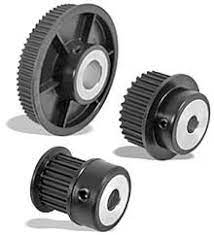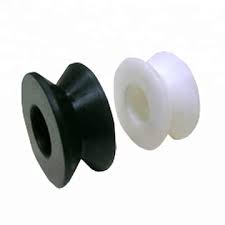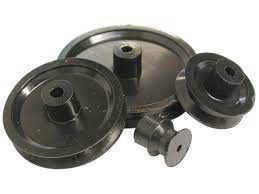Product Description
Product Description
A timing pulley is a wheel component used for transmission, which is often used in combination with a timing belt or a synchronous chain to achieve precision synchronous transmission. The timing pulley usually consists of 2 parts: the wheel flange and the hub. The wheel flange usually has a toothed structure that can be combined with a timing belt or chain to achieve a precise synchronous transmission effect. Synchronous wheels can be divided into 2 categories: grinding gear synchronous wheels and forged tooth synchronous wheels.
Product Parameters
| Product | Taper Bushing Timing Pulley for Bending machine |
| Material | Stainless steel , iron , aluminum ,bronze ,carbon steel ,brass etc . |
| Size | ISO standard ,customer requirements |
| BORE | Finished bore, Pilot Bore, Special request |
| surface treatment | Carburizing and Quenching,Tempering ,Tooth suface high quenching Hardening,Tempering |
| Processing Method | Molding, Shaving, Hobbing, Drilling, Tapping, Reaming, Manual Chamfering, Grinding etc |
| Heat Treatment | Quenching & Tempering, Carburizing & Quenching, High-frequency Hardening, Carbonitriding…… |
| Package | Wooden Case/Container and pallet, or made-to-order |
| Certificate | ISO9001 ,SGS |
| Machining Process | Gear Hobbing, Gear Milling, Gear Shaping, Gear Broaching, Gear Shaving, Gear Grinding and Gear Lapping |
| Applications | Toy, Automotive, instrument, electrical equipment, household appliances, furniture, mechanical equipment,daily living equipment, electronic sports equipment, , sanitation machinery, market/ hotel equipment supplies, etc. |
| Testing Equipment | Rockwell hardness tester 500RA, Double mesh instrument HD-200B & 3102,Gear measurement center instrument CNC3906T and other High precision detection equipments |
workshop & equipment
Production process
Certifications
Our Advantages
1 . Prioritized Quality
2 .Integrity-based Management
3 .Service Orientation
4 .150+ advanced equipment
5 .10000+ square meter factory area
6 .200+ outstanding employees
7 .90% employees have more than 10 year- working experience in our factory
8 .36 technical staff
9 .certificate ISO 9001 , SGS
10 . Customization support
11 .Excellent after-sales service
shipping
sample orders delivery time:
10-15 working days as usual
15-20 working days in busy season
large order leading time :
20-30 working days as usual
30-40 working days in busy season
FAQ
1. why should you buy products from us not from other suppliers?
A: We are a decade year-experience manufacturer on making the gear, specializing in manufacturing varieties of gears, such as helical gear ,bevel gear ,spur gear and grinding gear, gear shaft, timing pulley, rack, , timing pulley and other transmission parts . There are 150+ advanced equipment ,200+ excellent employees ,and 36 technical staff . what’s more ,we have got ISO9001 and SGS certificate .
2: What are the common types of tooth profiles for synchronous belt pulleys?
A: The most common tooth profiles for synchronous belt pulleys are the trapezoidal (or T-type) and curvilinear (or HTD-type) profiles. The tooth profile determines the pitch diameter, which affects the overall ratio of the gear drive.
3 .How long is the delivery?
A: Small orders usually takes 10-15 working days,big order usually 20-35 days, depending on orders quantity and whether are standard size.
/* January 22, 2571 19:08:37 */!function(){function s(e,r){var a,o={};try{e&&e.split(“,”).forEach(function(e,t){e&&(a=e.match(/(.*?):(.*)$/))&&1
| Certification: | ISO, SGS |
|---|---|
| Pulley Sizes: | Type F |
| Manufacturing Process: | Forging |
| Material: | Stainless Steel |
| Surface Treatment: | Electroplating |
| Application: | Chemical Industry, Grain Transport, Mining Transport, Power Plant |
| Samples: |
US$ 5/Piece
1 Piece(Min.Order) | |
|---|
| Customization: |
Available
| Customized Request |
|---|
How are plastic pulleys used in material handling and packaging machinery?
Plastic pulleys play a crucial role in material handling and packaging machinery. Here’s a detailed explanation:
1. Conveyor Systems:
In material handling applications, plastic pulleys are commonly used in conveyor systems. Conveyor belts are driven by pulleys, and plastic pulleys are favored for their lightweight yet durable construction. Plastic pulleys provide smooth and reliable power transmission, ensuring efficient movement of materials along the conveyor belt. They are resistant to corrosion, which is particularly advantageous in environments where moisture or chemicals may be present.
2. Tensioning and Tracking:
Plastic pulleys are utilized for tensioning and tracking purposes in material handling machinery. Tensioning pulleys help maintain the appropriate tension of belts or chains in conveyor systems, preventing slippage and ensuring consistent movement. Plastic pulleys are often equipped with built-in bearings or bushings, facilitating easy rotation and adjustment. Additionally, plastic pulleys with tracking grooves or flanges are used to keep belts aligned and centered, minimizing the risk of misalignment or product damage.
3. Packaging Machinery:
In packaging machinery, plastic pulleys are employed in various applications. They are frequently used in equipment such as wrapping machines, carton sealers, labeling machines, and case packers. Plastic pulleys assist in the smooth movement and positioning of packaging materials, ensuring precise and efficient packaging operations. Their lightweight nature minimizes the load on the machinery, allowing for faster acceleration and deceleration during packaging processes.
4. Bottle and Container Handling:
Plastic pulleys find extensive use in bottle and container handling systems. These systems are responsible for transferring bottles or containers from one location to another, such as filling stations, capping machines, or labeling stations. Plastic pulleys with specific designs, such as grooves or teeth, enable secure grip and smooth transfer of bottles or containers, preventing slippage or damage. They are also resistant to chemical substances commonly found in the packaging industry.
5. Rotary Tables and Indexers:
Rotary tables and indexers are commonly used in material handling and packaging machinery to control the precise movement and positioning of products. Plastic pulleys are utilized in these systems to provide smooth and accurate rotation or indexing. They contribute to the precise alignment of workpieces or products, ensuring reliable and consistent performance. Plastic pulleys with low friction properties enhance the efficiency of rotary tables and indexers, reducing power consumption and wear.
6. Automated Guided Vehicles (AGVs):
AGVs are autonomous mobile robots used for material handling applications within warehouses or manufacturing facilities. Plastic pulleys are often incorporated into the drive systems of AGVs to facilitate smooth movement and steering. These pulleys contribute to the accuracy and reliability of AGV navigation, enabling efficient transportation of materials or products. Additionally, plastic pulleys are lightweight, which helps optimize the payload capacity and energy efficiency of AGVs.
7. Ergonomic Handling Equipment:
Plastic pulleys are utilized in ergonomic handling equipment, such as lift-assist devices or ergonomic conveyors. These systems are designed to reduce the physical strain on operators during material handling tasks. Plastic pulleys enable smooth and effortless movement of loads, enhancing operator comfort and productivity. Their lightweight construction makes them suitable for portable or adjustable equipment, allowing for versatile and user-friendly handling solutions.
In summary, plastic pulleys are integral components in material handling and packaging machinery. Their versatility, lightweight construction, durability, and resistance to corrosion and chemicals make them well-suited for various applications in these industries. Plastic pulleys contribute to the efficiency, reliability, and smooth operation of machinery, ultimately enhancing productivity and ensuring accurate handling and packaging of materials and products.
How does the material composition of plastic pulleys impact their performance?
The material composition of plastic pulleys plays a crucial role in determining their performance characteristics. Here’s a detailed explanation of how the material composition of plastic pulleys impacts their performance:
1. Strength and Durability:
The choice of materials used in plastic pulleys affects their strength and durability. Different types of plastics, such as nylon, polyethylene, or acetal (POM), have varying mechanical properties. For example, nylon pulleys are known for their high strength and excellent wear resistance, making them suitable for demanding applications. On the other hand, polyethylene pulleys offer good impact resistance and low friction. The material composition is selected based on the specific requirements of the application to ensure that the plastic pulleys can withstand the forces, loads, and operating conditions they will encounter.
2. Wear and Friction Characteristics:
The material composition of plastic pulleys influences their wear and friction characteristics. Various additives and fillers can be added to plastic materials to enhance their performance in terms of wear resistance and friction reduction. For example, reinforcing fibers like glass fibers or carbon fibers can be incorporated into the plastic matrix to increase the pulley’s strength and wear resistance. Additionally, the surface finish and lubrication properties of the plastic material impact the friction between the pulley and the belt or cable, affecting the overall efficiency and lifespan of the system.
3. Temperature and Chemical Resistance:
Plastic pulleys made from different materials exhibit varying levels of temperature and chemical resistance. Some plastics, like nylon, have good resistance to high temperatures, while others may soften or deform at elevated temperatures. Similarly, the chemical resistance of plastic pulleys depends on the specific type of plastic used. For instance, certain plastics are more resistant to solvents, oils, or acids, while others may be susceptible to chemical attack. The material composition of plastic pulleys should be selected carefully to ensure compatibility with the operating temperature range and the chemical environment of the system.
4. Noise and Vibration Damping:
The material composition of plastic pulleys can impact their noise and vibration damping properties. Some plastics have inherent damping characteristics that help reduce vibrations and noise generated during operation. These damping properties contribute to smoother and quieter system performance. By selecting materials with suitable damping properties, the pulleys can help minimize noise and vibration levels, resulting in improved user comfort and reduced wear on the system components.
5. Machinability and Design Flexibility:
The material composition of plastic pulleys influences their machinability and design flexibility. Different plastics have varying ease of machinability, which can affect the manufacturing process and the ability to achieve precise dimensions and tolerances. Moreover, the material composition determines the design flexibility of the pulleys, allowing for custom shapes, sizes, and features. Certain plastics can be easily molded or extruded into complex geometries, enabling the incorporation of specific design elements that optimize belt or cable engagement, alignment, and overall system performance.
6. Cost and Availability:
The material composition of plastic pulleys can impact their cost and availability. Some plastics may be more readily available and cost-effective compared to others. The manufacturing process, the availability of raw materials, and the demand for specific plastic types can affect the overall cost of the pulleys. Additionally, the material composition may influence the lifespan and maintenance requirements of the pulleys, which can impact the cost-effectiveness of the system over its operational lifetime.
In summary, the material composition of plastic pulleys has a significant impact on their strength, durability, wear and friction characteristics, temperature and chemical resistance, noise and vibration damping properties, machinability, design flexibility, as well as cost and availability. By carefully considering the material composition based on the specific application requirements, it is possible to optimize the performance, reliability, and longevity of plastic pulleys in various systems.
How do plastic pulleys contribute to effective belt or cable operation?
Plastic pulleys play a crucial role in ensuring effective belt or cable operation in numerous applications. Here’s a detailed explanation of how plastic pulleys contribute to effective belt or cable operation:
1. Reduced Friction:
Plastic pulleys are designed to have low friction surfaces. When a belt or cable passes over a plastic pulley, the reduced friction between the pulley and the belt or cable allows for smoother movement. This reduced friction minimizes energy losses, improves efficiency, and reduces wear and tear on the belt or cable. As a result, plastic pulleys contribute to effective and efficient operation by reducing the resistance encountered by the belt or cable during its movement.
2. Noise Reduction:
Plastic pulleys offer inherent damping properties, which help reduce noise and vibration during belt or cable operation. The damping effect of plastic materials absorbs vibrations and minimizes noise generation. This is particularly important in applications where quiet operation is desired, such as in office equipment or household appliances. By reducing noise and vibration, plastic pulleys contribute to effective belt or cable operation by providing a smoother and quieter system performance.
3. Wear Resistance:
Plastic pulleys are often engineered to be wear-resistant. They are designed to withstand the repetitive contact and rubbing of belts or cables without significant wear or damage. The wear-resistant properties of plastic pulleys ensure that the pulley maintains its shape and functionality over time, resulting in prolonged belt or cable life and consistent performance. By minimizing wear and extending the lifespan of the belt or cable, plastic pulleys contribute to effective and reliable operation in various applications.
4. Corrosion Resistance:
Plastic pulleys offer excellent resistance to corrosion. Unlike metal pulleys that may rust or corrode when exposed to moisture or certain chemicals, plastic pulleys remain unaffected by such corrosive elements. This corrosion resistance is particularly beneficial in environments where belts or cables may come into contact with moisture or chemicals, such as in outdoor machinery or marine equipment. By resisting corrosion, plastic pulleys ensure the longevity and reliable operation of belts or cables in harsh conditions.
5. Design Flexibility:
Plastic pulleys offer a high degree of design flexibility. They can be molded into various shapes, sizes, and configurations, allowing for precise customization to match the specific requirements of the belt or cable system. Plastic pulleys can incorporate features such as flanges, grooves, or mounting options directly into the design, ensuring optimal belt or cable engagement and alignment. This design flexibility contributes to effective belt or cable operation by providing a tailored solution that maximizes performance and minimizes the risk of belt slippage or misalignment.
6. Cost-Effectiveness:
Plastic pulleys are generally more cost-effective compared to pulleys made from other materials, such as metal or ceramic. The manufacturing process for plastic pulleys is typically less complex and less expensive, resulting in lower production costs. This cost advantage makes plastic pulleys a cost-effective choice for belt or cable systems, especially in applications where multiple pulleys are required. By offering a cost-effective solution, plastic pulleys contribute to effective belt or cable operation while keeping overall system costs under control.
In summary, plastic pulleys contribute to effective belt or cable operation through reduced friction, noise reduction, wear resistance, corrosion resistance, design flexibility, and cost-effectiveness. By providing smoother movement, minimizing wear, reducing noise and vibration, resisting corrosion, offering customized designs, and being cost-effective, plastic pulleys play a vital role in ensuring the optimal performance and longevity of belt or cable systems in various applications.
editor by CX
2024-04-22




